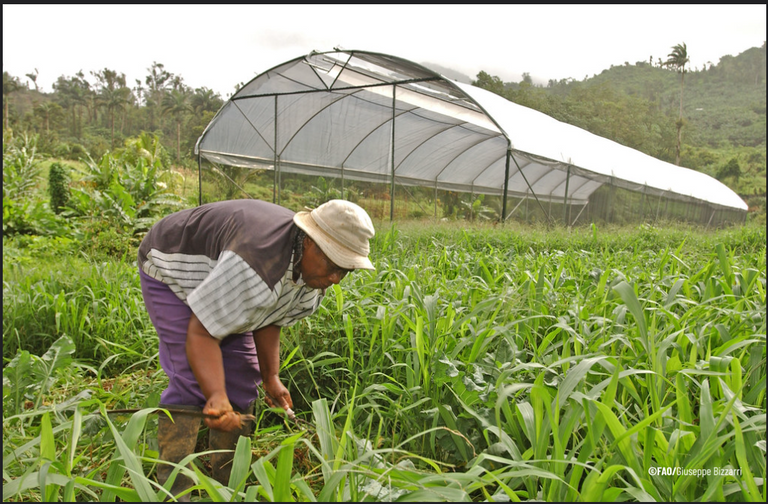Despite tons of efforts and resources invested into research seeking to better the existence of mankind, one major thing keeps eluding us, inadequate food. According to Food and Agricultural Organization, millions of people keep suffering from hunger. While the problem of hunger can partly be attributed to the wastage of food, on one hand, inadequate food production can be blamed on the other.
According to worldometer, the world's population keeps increasing at the rate of 1.05% per year, culminating in net average addition of 81 million people annually. The implication is that all hands have to be on deck in terms of food production, otherwise, the world's food crises may worsen.
Much has been done to improve food production, in all honesty. Advancement in technological innovation now makes it easy to practice agriculture. Cultivating lands, planting, weeding, fertilizer application, pesticide application, harvesting, processing of harvested produce, etc., are now as simple as the press of a button. Virtually every agricultural activities now have automation.
Despite all the automation and improved productivity through the use of machines, one thing remains limiting, and that is the essential nutrients for crop production. Trying to overcome this challenge has led to the emergence of synthetic fertilizers to augment the nutrients in the soil where they are inadequate. Although fertilizer application seems to work like magic, there are several problems associated with its usage.
One of the major problems associated with the use of synthetic fertilizer to boost crop production is its detrimental effects on the ecosystem at large. Runoffs from farmlands where synthetic fertilizers have been used usually cause an ecological problem known as eutrophication in aquatic ecosystems.

The runoffs from farmland where synthetic fertilizers are being used contain residual nutrients. These nutrients cause the water bodies where runoffs are discharged to become enriched. The enrichment sparks the blooming of aquatic plants, causing underwater species to die off from inadequate light and oxygen. On one hand, the blooming of aquatic species creates problems in waterway navigation by boats, and on the other hand, the decrease in oxygen levels of water bodies triggers the death of aquatic animals. Decaying aquatic species in eutrophicated waters gives the water bodies a bad aesthetic appearance as well as obnoxious odours.
Apart from causing enrichment of aquatic environment, excessive use of fertilizers also has the capacity to cause disequilibrium in the natural nutrient supply in soils thereby rendering soils unsuitable for farming in the long run.
In the continuous effort to find a lasting solution to the problems associated with the use of synthetic fertilizers, scientists have delved into the world of nanoparticles. I first came across the use of nanoparticles in boosting crop output from the research of a colleague. The research, although yet to be published, investigated the effects of silver nanoparticle application on the yield of Chorchorus olitorus, also known as jews mallow.
What he did was to set up two groups of C. olitorus plants in the screen house under the same growth condition except that the treatment group had silver nanoparticles applied to them. Data on growth and eventual yield were collected from about 8 weeks and one-way analysis of variance of the data showed that the treatment group had significantly higher growth and yield than the control group.
The findings from my colleague's research piqued my interest in the subject and further investigation showed that the application of nanoparticles in crop production is a practice that is gaining traction, especially in the advanced world.
Nanotechnology is now being used in the production of fertilizers themselves. Nanoparticles in fertilizers not only improve crop productivity but can also be used to regulate the delivery of nutrients as well as the target sites of these deliveries (using biosensors). By doing so, excessive use of fertilizers can be curtailed and the ecological impact reduced to the barest minimum.
According to Mikkelsen (2018), nanofertilizers, as they are favouritely called, are classified into 3 based on the position of the nanoparticles in the fertilizer. They are
- Nanoscale fertilizers
- Nanoscale coating fertilizers
- Nanoscale additive fertilizers
Except for the nanoscale fertilizers that are essentially made of nanoparticles mixed with some essential crop nutrients, the rest are more or less normal synthetic fertilizers mixed with (nanoscale additive) or coated (nanoscale coating) with nanoparticles.
While the subject of nanoparticles and improving crop yields remains an active area of research investigations, excluding traditional fertilizers from future innovations targeting improved crop yield may be very important for the integrity of our ecosystems. Hopefully, element-specific nanoparticles can replace traditional fertilizers totally in the nearest future. Not just that, an innovation for the controlled release of the nutrients would be very essential.
Your comments and contributions are welcomed. Thank you all for reading.
Resources
Mikkelsen, R. (2018). Nanofertilizer and Nanotechnology: a quick look. Better Crops 102, 18–19. doi:10.24047/BC102318
https://www.azonano.com/article.aspx?ArticleID=5446
https://www.frontiersin.org/articles/10.3389/fenvs.2021.635114/full
https://www.frontiersin.org/articles/10.3389/fnano.2020.579954/full
https://www.ncbi.nlm.nih.gov/pmc/articles/PMC6680665/


